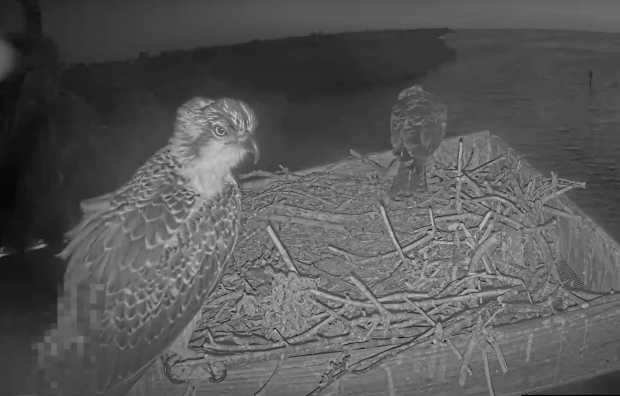6-7 June 2022
‘R’ sent me a lovely note. She had trouble with the link that I provided for the fundraising by the Eagle Club of Estonia for the three surviving storklets of Jan and Janika. If you had difficulties, too, please try this link that ‘R’ sent to me:
https://www.leetchi.com/c/kotkaklubi
There is good news coming from Robert Fuller. The first of the six kestrels raised by Papa Kestrel fledged on 6 June. Oh, what a joyous day! No one knew what would happen when Mum Kestrel did not return. The males are so tuned in to providing prey and security that feeding and brooding chicks can be problematic. Imagine trying to be both Mum and Dad to six fast growing Kestrels. You might recall that Robert Fuller removed the youngest and smallest three. They were kept warm and fed regularly to give them a good start when they would be returned to the nest with their bigger siblings. Father Kestrel learned how to feed his chicks and brood them. The first flight of one of the six really shows how working together -humans and raptors – success can be achieved.
Here is a quick video of that first fledge:
So far, Bukacek and Betty are still feeding five White Storklets on their nest in Mlade Buky. No brood reduction has taken place yet despite the youngest being substantially smaller than the others.
Bukacek has returned to the nest allowing Betty to go for a break and to get some food while he feeds the storklets and broods them.

Here is another feeding. You can see just how quickly the little storklets grow – and it is so nice that the sun is shining and the nest has dried out.
Karl II and Kaia have all their storklets as well. Karl arrived and fed the storklets an enormous feed! You would almost think he found Urmas’s fish basket! Notice how yellow the beaks are. It is a sign of a healthy storklet.
Liberty and Freedom seem to be liking their new nest in Glacier Gardens in Alaska. Didn’t we just get news of a pip and then a hatch and now – . Well. GG7 is named Love and s/he is 8 days old. GG8 is called Peace and s/he is 5 days old. Both are doing well. Gosh, I really appreciate those names. The world could seriously use much more ‘love’ and ‘peace’. Very appropriate for the times we live in. Oh, so delicate. Look at that teeny little flake of fish being held by that huge beak. So cute.

Takota is 70 days old. Mr President and Lotus have been busy bringing in food to their bouncy branching eaglet at the National Arboretum nest in Washington, DC.
The fledge times for Bald Eagles is normally 10-12 weeks so Takota is right at the beginning of that range. Males normally fledge earlier than females. Takota has really been working those wings! They are getting stronger and stronger.



Was it a fludge? or a fledge? When Ahote took off from the West End nest and wound up on Transmitter Hill? Ahote returned to the natal nest and to his siblings, Kana’kini and Sky on Monday after being off nest for 4 days. He stayed 7 hours before taking off again. Don’t blink. The video is short but it shows Ahote totally in command of his flying. Well done, Ahote!
A fish was delivered and Ahote took it so he has eaten -. Well done. You might well notice that the parents do not always fly right in with the kids after fledge. The fledglings are as large as their parents – actually slightly larger – and could injure them in the transfer of prey items. The adults are, thus, very cautious.



It looks like it could be a fledge for L1 today at the nest of Big Red and Arthur in Ithaca, New York. The little red-tail hawk has been antsy for days. The winds are strong. She has been up on the rails doing cute faces to the camera and on and off the fledge ledge all morning.
Just look at that face – sweet. And that beautiful peach plumage. Red-tail hawklets are gorgeous! (OK. They all are!).




So far, Middle has not fledged at the UFlorida-Gainesville nest since all the hovering and flapping activity yesterday. It rained heavy and the nest is soaking. Middle did get the fish off of Big this morning that was delivered at 11:11:01. This is the second day in a row that Middle’s confidence is up and he is taking what he wants.


R2 paid a visit to the nest of his parents Ron and Rita at the Miami Zoo. Normally a parent would fly in with food. R2 waited but nothing was delivered.

Grinnell Jr and Lindsay are losing their baby down quickly. Breakfast came at 0533 and the morning was spent flapping and running and exploring around the scrape. Annie and Alden have done a super job with these two.

Grinnell Jr has the blue leg ring.

It could be building up to be an exciting day with so many set to fledge. It is not clear if Little Bit 17 at the ND-LEEF has had any food. There is the possibility of some when 15 got the fish this morning. The lack of camera coverage on the porch area means that we just don’t know for certain when the little one gets food – or not. Hoping for fish, lots of fish.
Thank you so much for joining me. Have a lovely day! See you soon.
Thank you to the following for their streaming cams where I took my screen captures: The Eagle Club of Estonia, Mlade Buky Storks, Cornell Bird Lab RTH, WRDC, Explore.org and the Institute for Wildlife Studies, UFlorida-Gainesville Ospreys, Cal Falcons, Glacier Gardens, and the NADC-AEF.





















































































































































